Ahead of this match, RB Leipzig had 33 points and sat in the first position of the Bundesliga. However, Borussia Monchengladbach had 31 points while Borussia Dortmund collected until then 29 points. Considering this, the clash between Leipzig and Dortmund meant that the league leaders would face the team in the third position away from home.
This was clearly the highlight of the 16th matchday as the two teams met in the Signal Iduna Park just one week ahead of Christmas. Additionally, after this matchday, there would be just another one left ahead of the winter break.
In this tactical analysis, we’ll look at both teams’ tactics and discuss with the aid of analysis why this game ended 3-3 after a thrilling 90 minutes.
Lineups
The young German coach Julian Nagelsmann went for a 4-3-1-2 formation which looked during the game more like a 4-3-3. Péter Gulácsi was the man between the sticks while the back four in front of him was made of Marcel Halstenberg, Dayot Upamecano, Lukas Klostermann, and Nordi Mukiele. The central midfielders were Konrad Laimer, Diego Demme, and Marcel Sabitzer. The wingers were Timo Werner and Yussuf Poulsen while Emil Forsberg was surprisingly the striker as he mostly was between Werner and Poulsen and not behind them.
On the other side, Lucien Favre lined his team up in a 3-4-3 (5-4-1) formation with Roman Bürki in goal. The back five was made of Achraf Hakimi, Manuel Akanji, Mats Hummels, Dan-Axel Zagadou, and Raphael Guerreiro. Julian Weigl and Julian Brandt occupied the central midfield while Marco Reus was the central man upfront. Thorgan Hazard and Jadon Sancho were the wingers.
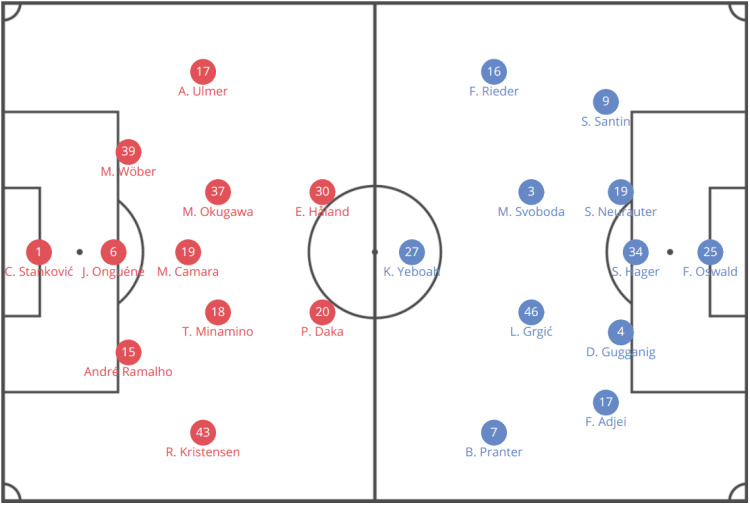
Leipzig’s pressing and Dortmund’s solution
Normally you would expect from these two teams to execute right from the beginning an aggressive and high pressing. Dortmund did so in the opening minutes, but then mostly sat back deeper as we’ll see later in this analysis. Meanwhile, Nagelsmann’s team tried right from the start on to not give Dortmund any time to breathe.
BVB used a similar formation during the build-up as is shown on the teamsheet. The back three was positioned a bit wider to not be that close to each other, while the wing-backs positioned near the touchline and a few yards higher. Weigl and Brandt were responsible for the progression of the ball through the centre and due to that, were in front of the back three. Meanwhile, the three forwards moved quite freely and appeared in different spaces.
Anyways, as it is typical for Leipzig, they used a high pressing right from the first whistle of the ref. They put pressure on Hummels, Akanji, and Zagadou extremely high up the pitch as it can be seen in the image below.
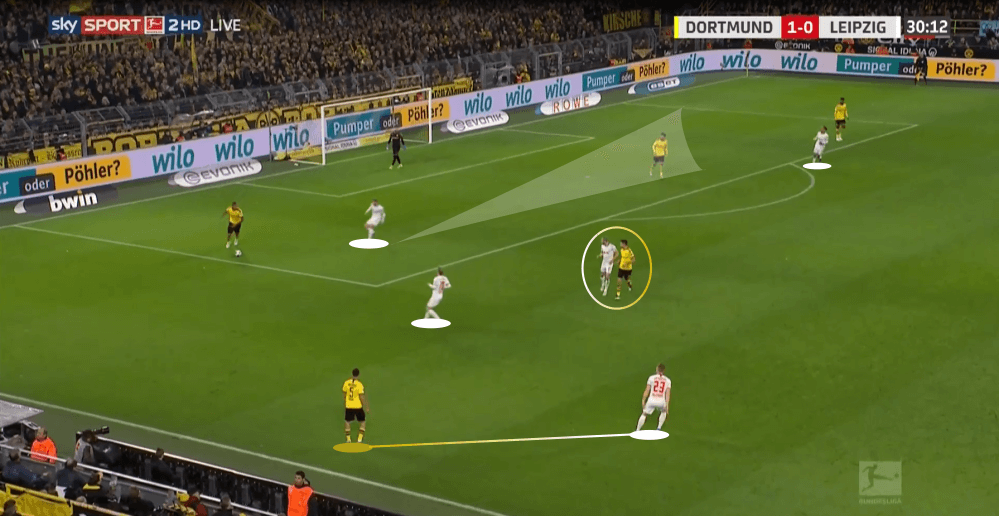
However, in these situations, you already could see what was one of Favre’s ideas behind the back five and back three respectively. As Nagelsmann’s team put pressure on the ball carrier and wanted to create numerical equality and superiority respectively around the ball, they shifted extremely to the according side of the pitch. Logically, this caused a huge empty space to occur on the opposite wing. This free room was exploited by Dortmund as the wing-backs stayed wide and so their teammates easily found them with long balls to solve the press of Leipzig. This can be seen in the example below.
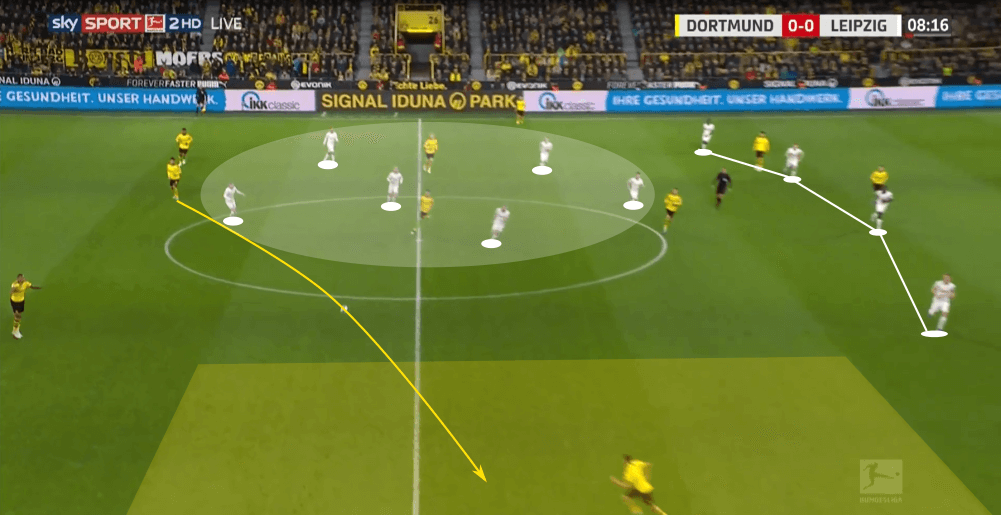
Favre’s team used throughout the match this pattern to either progress the ball when Leipzig used a high press or when they had to get out of a counter-press of Leipzig. On both occasions, these long passes to the free wing helped them massively.
We also saw another tactic which Dortmund used to progress the ball up the field when Nagelsmann’s team pushed forward to put pressure on BVB: vertical passes to Reus or Brandt. Since Weigl and Brandt were the only two men in the central midfield, it was clear that they would need some more support in the situations in which Dortmund wanted to free themselves through the centre. On such occasions, Reus and Brandt used their ability to find free spaces and open up passing lanes with their intelligent movements.
However, the opposition then sometimes made the mistake of not having the whole team rush forward. When you want to execute a high press or counter-press, the defence (in this case, Leipzig’s back four) must also move forward to keep the vertical compactness. As you can see in the example below, Dortmund can play a vertical pass to find Brandt, but Leipzig’s back four didn’t position high enough during the pressing. Due to this, the young German can turn and dribble forward to get into a situation which makes it hard for Leipzig to defend against.
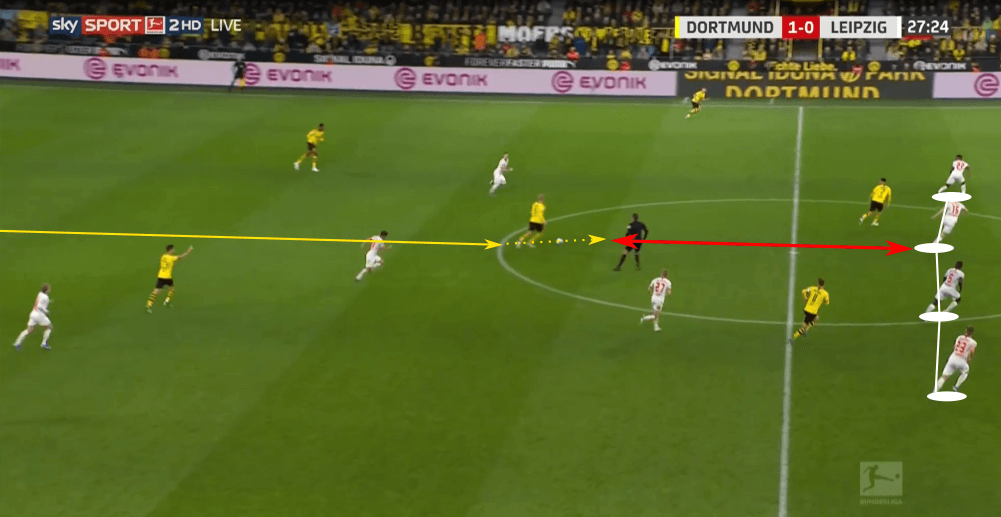
Logically, a team can’t execute such a high and aggressive press as Leipzig did over the full course of 90 minutes. Because of this, they dropped back deeper after some time so as to not put pressure on Dortmund that high up anymore. In these situations, we perfectly saw the 4-3-3 formation of Leipzig with the usual strikers, Poulsen and Werner, on the flanks while Forsberg was the man in the middle. This system can be seen in the example below. Leipzig did especially a good job in staying vertically compact to avoid the chance of Dortmund finding players like Brandt, Reus, Hazard, or Sancho that often with penetrating passes in the spaces between the lines.
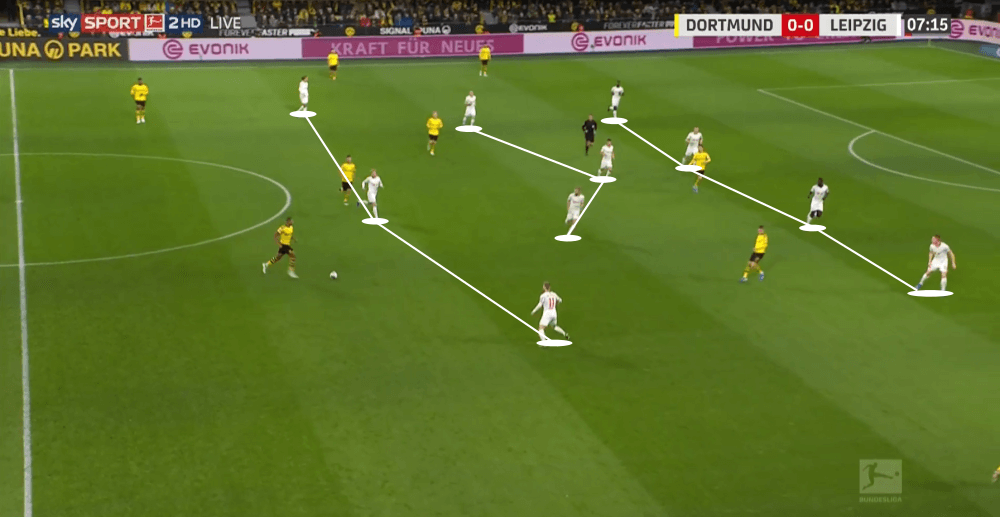
Furthermore, Leipzig wanted to get an advantage out of their numerical superiority in the centre. Because of this, two of the three central midfielders Laimer, Demme, and Sabitzer man-marked Weigl and Brandt when Leipzig sat back deeper in their 4-3-3 formation. There was no clear rule on who should follow whom as they changed it when they shifted from one side to the other. For example, in the shot below Laimer man-marks Weigl while Sabitzer looks after Brandt and Demme is the free man.
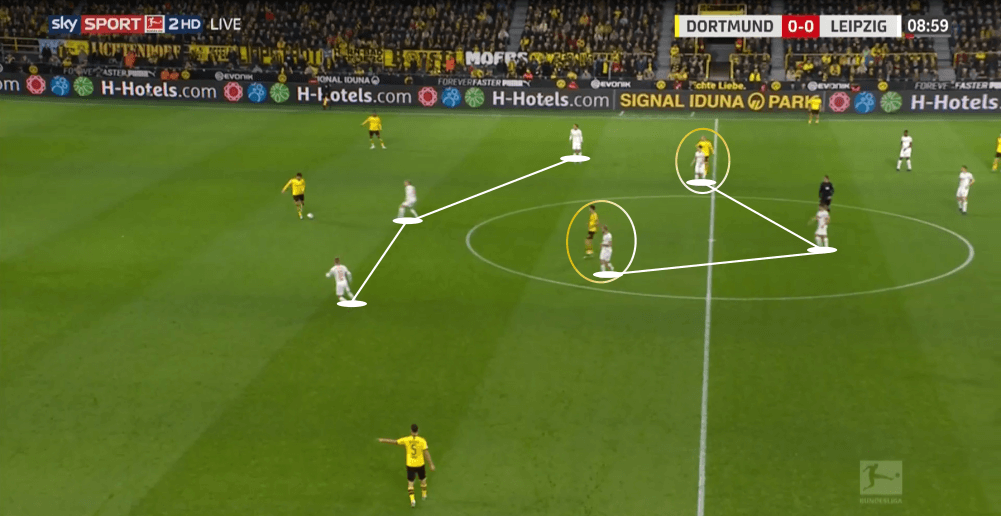
Typical movements in the final third
Considering the aspects above, Dortmund were quite often able to bypass the press of Leipzig and as Nagelsmann’s team sat back deeper they easily reached the final third. When Favre’s team got there, we saw two patterns which are especially typical for BVB and ones which we have already seen often in this and last season.
However, Leipzig had a hard time defending against these movements and ideas of Dortmund. As we already have seen, the back five had the advantage to easily switch the side during Leipzig’s press, but now we see a second advantage. As Akanji, Hummels, and Zagadou are together with Weigl, this gave enough protection, the wing-backs had the freedom to push high up during the attacks and support the front three (and Brandt). As we already have seen, the three forwards had a lot of freedom to be positioned in different spaces. Therefore, they were rarely positioned on the wings that allowed the wing-backs, Hakimi and Guerreiro, to push forward.
As soon as they got on the ball in the wide areas, one of the front three drifted to the outside to support them and eventually create 2 vs 1 or 2 vs 2 situations. This was possible since the wingers Werner and Poulsen didn’t always come back to help their full-backs. Favre wanted to take an advantage out of that, and his team tried to get into such situations on the wing as you can see in the example below.
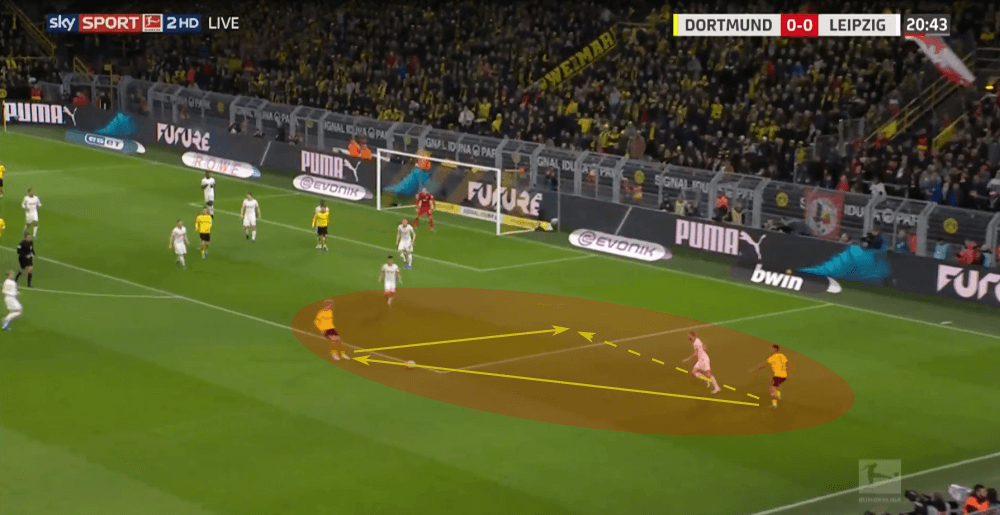
Ahead of the 2-0, we saw a similar situation in which Sancho received the ball in the wide-area as can be seen in the image below. Poulsen and Sabitzer are positioned too high to get into a defensive duel or support Mukiele. Meanwhile, the wing-back Guerreiro starts a deep run on the inside (which we’ll come back to later) and Laimer has to follow him. Due to that, the Austrian can’t support the right-back Mukiele and Dortmund easily created a one-on-one situation.
Additionally, notice that Brandt joined Hazard and Reus in the centre as Sancho went to the outside. Because of this, we have numerical equality in the penalty area just seconds later and Hakimi also comes in from the opposite wing. Sancho will pass the ball to Brandt who then scores after an amazing turn. We have to consider that in this situation we can see the full class of Sancho and Brandt, but it’s also predictable they could use their talent easily when both just have one direct opponent and so much space.
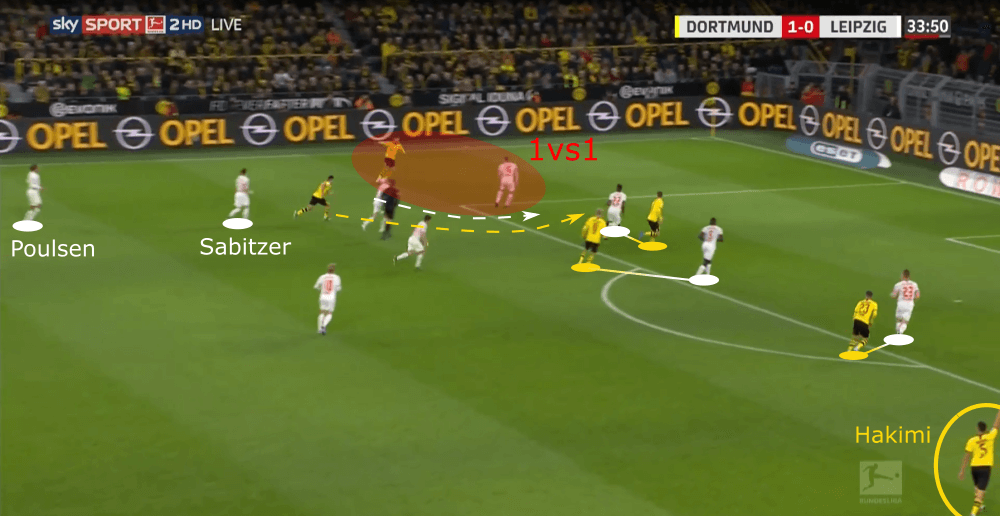
Now we’ll look at a combination of movements and passes in the final third which is maybe more typical for Favre’s Dortmund than any other aspect of their game. We already saw an underlapping run of Guerreiro in the situation ahead of the 2-0, which forced Laimer to follow him and helped to create a one-on-one situation for Sancho.
This underlapping run and the according through pass as can be seen below is this typical pattern mentioned earlier, and we can see Dortmund doing this several times per game. However, we mostly witness this after this through pass, as the player who got behind the last line of the opposition just plays the ball back. He often doesn’t have to look if there is a teammate who could convert it since Favre’s men know that they have to occupy the according space in the penalty box when this typical through pass is played.
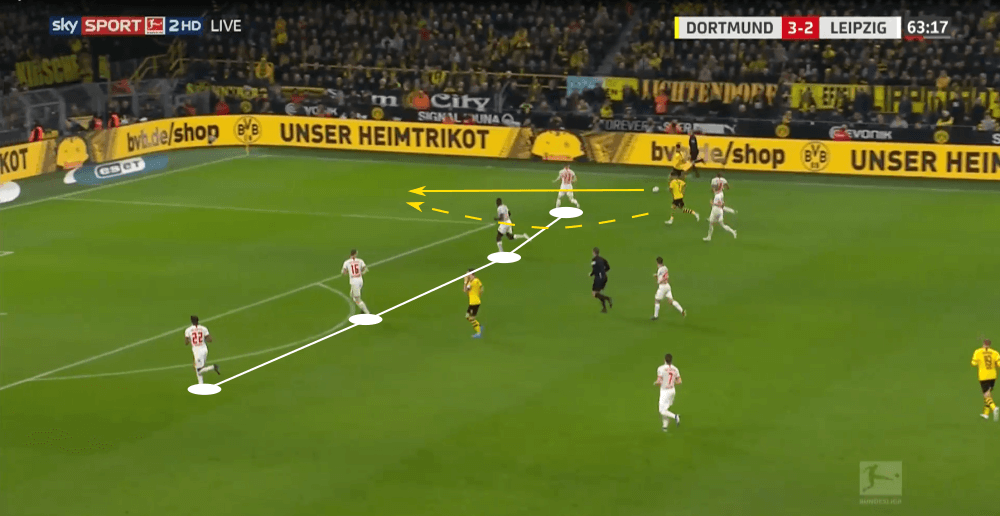
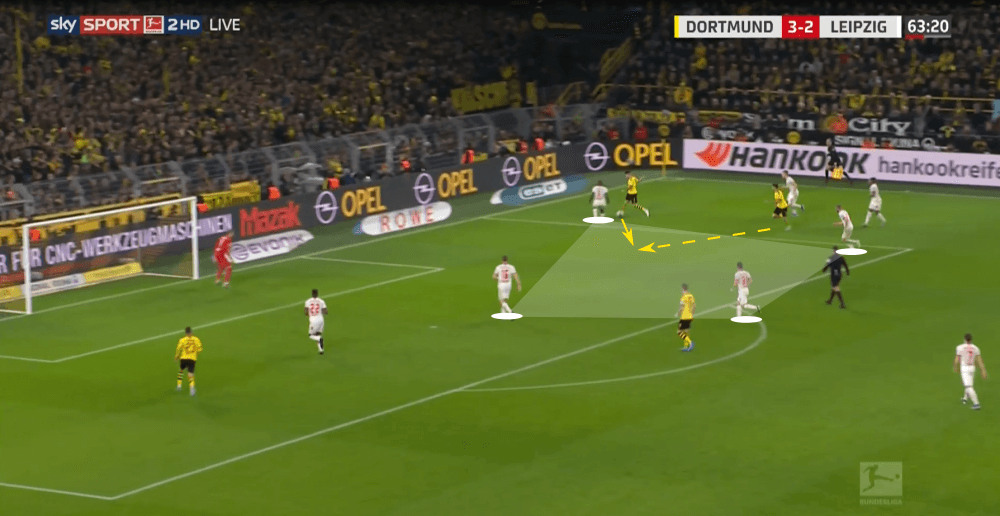
In this match, BVB once more tried to create goalscoring chances with the aid of this pattern several times in the game. We either saw that one of the wingers were positioned wider and the wing-backs provided the deep run, or the other way around. Ahead of the 2-0 the wing-back Guerreiro made the underlapping run, while ahead of the 3-2 it was Reus who started from a central position and then received a perfect through pass from the right wing-back Hakimi. Reus played the ball into the centre where Sancho then scored to make it 3-2.
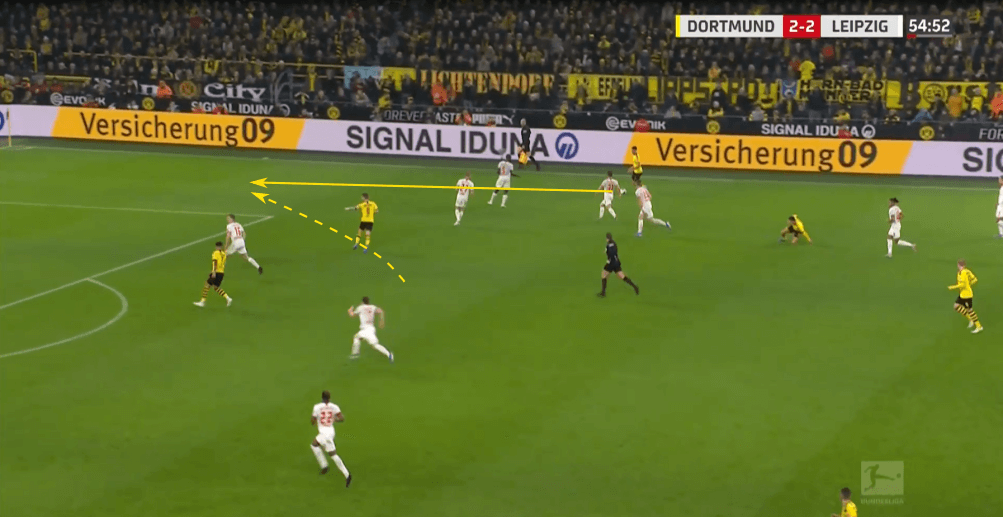
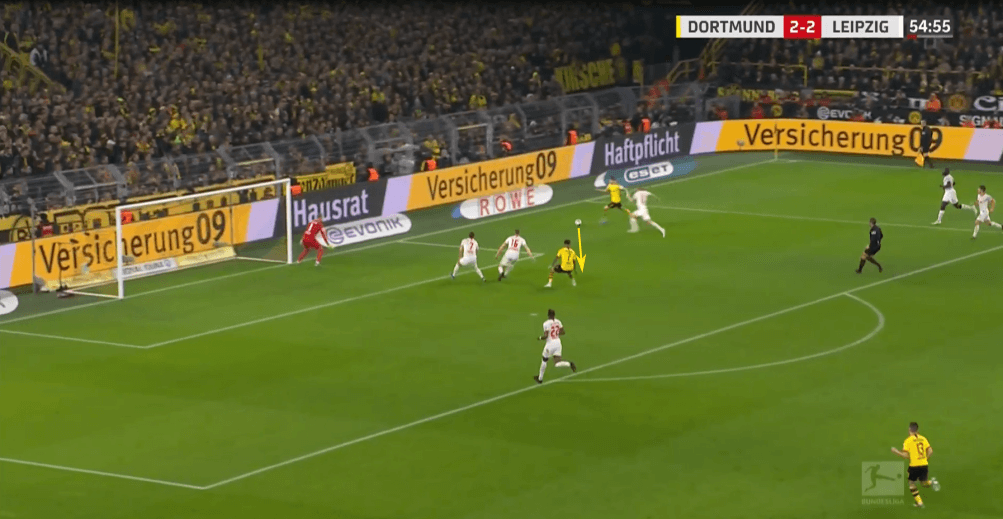
Leipzig are harmless, but individual errors save them
At the halftime break, it seemed as Leipzig would stand no chance against Dortmund. Favre’s team were 2-0 ahead as Weigl scored from distance and Brandt was the second scorer as we already looked at his goal earlier in this analysis. Meanwhile, Leipzig were shockingly harmless and didn’t look as they could get dangerous at all.
During their build-up phase, Demme was mostly positioned extremely deep to support the two centre-backs Upamecano and Klostermann. The full-backs were positioned a bit higher, but in general, stayed quite deep to give the centre-backs a passing option. Laimer and Sabitzer moved in the half-spaces to provide vertical passing options while the front three were mostly positioned quite narrow. Poulsen and Werner were either positioned in the space between the wing-backs and the centre-backs or next to the centre-backs. Forsberg never truly got into the game and got subbed off in halftime. Meanwhile, Dortmund sat back deep in a 5-4-1 formation and tried to keep the distance between the players short and the space between the two lines small. BVB switched between a 5-4-1 and 5-3-2 formation depending on Sancho’s positioning.
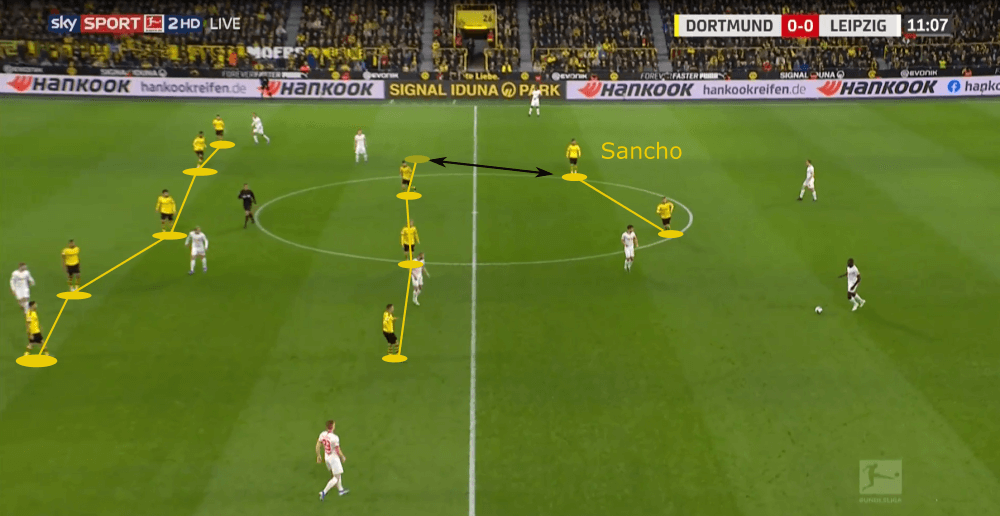
Laimer and Sabitzer were the only two men who at least tried to provide any vertical passing options while the three forwards were mostly positioned on the height of BVB’s back five and the full-backs were positioned too deep. Due to this, Nagelsmann’s squad had a very hard time to progress the ball further up the pitch. Because of the lack of short passing options and the compact shape of Dortmund, Leipzig seemed to get impatient and often operated with long balls which the three centre-backs of Dortmund easily defended. Their second idea was to find, for example, Werner with diagonal through passes as they wanted to play through the gaps of the back five. However, this also never really paid off as BVB kept the distance between the players so short, as can be seen in the image below.
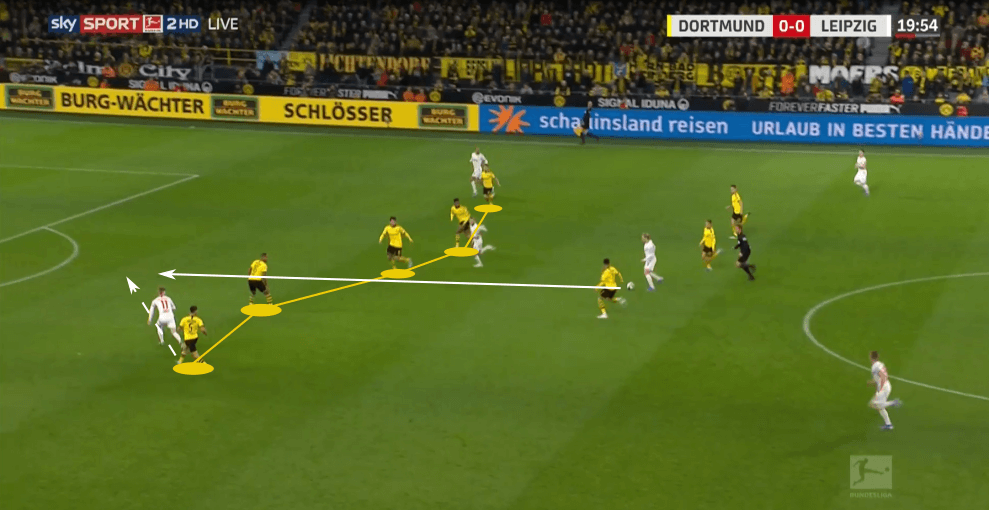
So after the first 45 minutes, Dortmund were 2-0 ahead and it didn’t seem as though Leipzig would have a chance to get back into this game. However, Nagelsmann made a little adjustment as he brought on Christopher Nkunku for Forsberg. Because of this, Werner went into the centre and the Frenchman occupied the left wing. This substitution wasn’t the great turning point of the match, but it was noticeable how it helped Leipzig since: firstly, Werner was more present in the centre and he seemed to feel more comfortable; and secondly, Nkunku performed better than Forsberg who looked a bit tired.
The two goals which were scored in the 47th and 52nd minute both resulted out of individual errors by Dortmund which can be seen in the shots below. In both situations, Werner was the one who took advantage of them.


Conclusion
Just moments after Leipzig’s equaliser Dortmund scored the 3-2 which we already analysed. Nagelsmann’s team were able to score the 3:3 in the 77th minute, but in general, you had to admit that Dortmund were the better team and that the individual errors of Bürki and Brandt cost them the three points.
Favre’s team showed that they are still serious title contenders while Leipzig already had much better performances this season. On the 17th and last matchday ahead of the winter break, Dortmund will face Hoffenheim and Leipzig plays at home against Augsburg. This draw means that BVB can’t be above Leipzig in the table during the winter break since there are still four points between them, but it guarantees us an interesting second half of the season.

If you love tactical analysis, then you’ll love the digital magazines from totalfootballanalysis.com – a guaranteed 100+ pages of pure tactical analysis covering topics from the Premier League, Serie A, La Liga, Bundesliga and many, many more. Buy your copy of the December issue for just ₤4.99 here





Comments